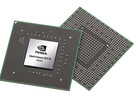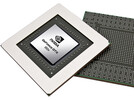NVIDIA GeForce GTX 860M SLI vs NVIDIA GeForce GTX 880M SLI
NVIDIA GeForce GTX 860M SLI
► remove from comparison
The NVIDIA GeForce GTX 860M SLI is a high-end DirectX 12-compatible graphics solution for laptops, consisting of two GeForce GTX 860M. Each card has a 28 nm GM107 core based on the Maxwell architecture. The clocks for the SLI-setup are identical to a single GTX 860M. With SLI, each card usually renders a single frame (AFR mode). Therefore, it may suffer from micro stuttering in low fps ranges of 30fps. This happens because of different timespans between two frames (e.g., irregular delays between sequential frames).
Alternatively, there is also a version based on the Kepler chip GK104, which has 1152 shader units clocked at 797 MHz.
Architecture
Compared to Kepler, Maxwell has been optimized in several details to increase power efficiency. Smaller Streaming Multiprocessors (SMM) with only 128 ALUs (Kepler: 192) and an optimized scheduler should lead to better utilization of the shaders. Nvidia promises that a Maxwell SMM with 128 ALUs can offer 90 percent of the performance of a Kepler SMX with 192 ALUs. Each of the two GM107 features 5 SMMs and thus 640 shader cores, 40 TMUs and 16 ROPs (128-bit interface).
Another optimization is the massively enlarged L2 cache (GM107: 2 MB). The increased size can handle some of the memory traffic to allow for a relatively narrow memory interface without significantly reducing the performance.
Similar to Fermi and Kepler, Maxwell / GM107 supports DirectX 12 with feature level 11.0 only.
Performance
The GeForce GTX 860M SLI is about 70 - 80 percent faster than a single GTX 860M, leading to a performance somewhere between a single GeForce GTX 680 (desktop) and Radeon R9 280X (desktop). Accordingly, the 860M SLI competes with the high-end single-GPU GeForce GTX 880M. Most games (as of 2014) are playable at the highest detail setting and in FullHD resolution. In many cases it is even possible to activate additional anti-aliasing.
Features
GM107 integrates the sixth generation of the PureVideo HD video engine (VP6), offering a better decoding performance for H.264 and MPEG-2 videos. Of course, VP6 supports all features of previous generations (4K support, PIP, video encoding via NVENC API). Unfortunately, HDMI 2.0 is still not supported.
Power consumption
The power consumption of the GeForce GTX 860M SLI should double from 60 to about 120 watts (including board and memory) compared to a single GTX 860M. Therefore, only large desktop replacements can handle the heat.
NVIDIA GeForce GTX 880M SLI
► remove from comparison
The NVIDIA GeForce GTX 880M SLI is a high-end DirectX 12-compatible graphics card for laptops, consisting of two GeForce GTX 880M. Each card has a 28nm GK104 core based on the Kepler architecture. The clocks for the SLI-setup are usually identical to a single GTX 880M. With SLI, each card renders a single frame (AFR mode). Therefore, it may suffer from micro stuttering in low fps ranges of 30fps. This happens because of different timespans between two frames (e.g., irregular delays between sequential frames).
Architecture
The Kepler architecture is the successor to the Fermi architecture that first appeared in laptops with the GeForce 400M series. The GK104 Kepler core offers eight shader blocks, called SMX, that are clocked at the same speed as the central core. In the GTX 880M, all eight blocks are active for a total of 1536 CUDA cores. Although the Kepler architecture can utilize more shader cores than a Fermi chip, its shaders can be up to twice as power efficient. However, due to the missing hot clock of the shader domain, two shaders of a Kepler chip are of similar speed to one shader of a Fermi chip (as the latter is clocked twice as fast).
The mobile Kepler series supports PCIe 3.0 as well as an optional Turbo mode, which can automatically overclock the card if the laptop cooling system allows it. This boost is supported by every GeForce 800M GPU.
Performance
Similar to our single GPU benchmarks, the GTX 880M SLI outperforms the GeForce GTX 780M SLI by about 10 percent. This makes the SLI configuration of two GTX 880M the currently fastest mobile graphics solution on the market (as of early 2014). With good driver support, SLI almost doubles the performance of a single card, allowing fluent frame rates even with FullHD resolution and highest detail settings.
Features
The feature set includes support for up to 4 active displays. Furthermore, high resolution monitors of up to 3840x2160 pixels can be connected using DisplayPort 1.2 or HDMI 1.4a (if available). HD-Audio codecs, such as Dolby TrueHD and DTS-HD, can be transmitted via bitstream mode through the HDMI port. However, as most laptops will feature Optimus, the integrated GPU will likely have direct control over the display ports and may limit the feature set available by the Nvidia Kepler cards.
The 5th generation PureVideo HD video processor (VP5) is also integrated in the GK104 core and offers hardware decoding of HD videos. Common codecs such as MPEG-1/2, MPEG-4 ASP, H.264 and VC1/WMV9 are fully supported up to 4K resolutions while VC1 and MPEG-4 are supported up to 1080p. Two streams can be decoded in parallel for features such as Picture-in-Picture. Another novelty is the inclusion of a dedicated video encoding engine similar to Intel QuickSync that can be accessed by the NVENC API.
Power Consumption
The power consumption of the GeForce GTX 880M SLI should double to at least 200 Watt (including board and memory) compared to a single GTX 880M. Therefore, only large desktop replacements can handle the heat.
| NVIDIA GeForce GTX 860M SLI | NVIDIA GeForce GTX 880M SLI | |||||||||||||||||||||||||||||||||||||
| GeForce GTX 800M Series |
|
| ||||||||||||||||||||||||||||||||||||
| Architecture | Maxwell | Kepler | ||||||||||||||||||||||||||||||||||||
| Pipelines | 1280 - unified | 3072 - unified | ||||||||||||||||||||||||||||||||||||
| Core Speed | 1029 MHz | 954 MHz | ||||||||||||||||||||||||||||||||||||
| Memory Speed | 5000 MHz | 5000 MHz | ||||||||||||||||||||||||||||||||||||
| Memory Bus Width | 2x 128 Bit | 2x 256 Bit | ||||||||||||||||||||||||||||||||||||
| Memory Type | GDDR5 | GDDR5 | ||||||||||||||||||||||||||||||||||||
| Max. Amount of Memory | 2x 4096 MB | 2x 8192 MB | ||||||||||||||||||||||||||||||||||||
| Shared Memory | no | no | ||||||||||||||||||||||||||||||||||||
| API | DirectX 12 (FL 11_0), Shader 5.0, OpenGL 4.3 | DirectX 12 (FL 11_0), Shader 5.0, OpenGL 4.3 | ||||||||||||||||||||||||||||||||||||
| Power Consumption | 120 Watt | 206 Watt | ||||||||||||||||||||||||||||||||||||
| Transistors | 0 Billion | 0 Billion | ||||||||||||||||||||||||||||||||||||
| technology | 28 nm | 28 nm | ||||||||||||||||||||||||||||||||||||
| Features | Battery Boost, GameStream, ShadowPlay, GPU Boost 2.0, Optimus, PhysX, CUDA, SLI, GeForce Experience | Optimus, SLI, PhysX, Verde Drivers, CUDA, 3D Vision, 3DTV Play | ||||||||||||||||||||||||||||||||||||
| Notebook Size | large | large | ||||||||||||||||||||||||||||||||||||
| Date of Announcement | 12.03.2014 | 12.03.2014 | ||||||||||||||||||||||||||||||||||||
| Codename | N15E-GX-A2 | |||||||||||||||||||||||||||||||||||||
| Link to Manufacturer Page | www.nvidia.de |
Benchmarks
3DM Vant. Perf. total + NVIDIA GeForce GTX 860M SLI
specvp12 sw-03 + NVIDIA GeForce GTX 880M SLI
Cinebench R15 OpenGL 64 Bit + NVIDIA GeForce GTX 860M SLI
Average Benchmarks NVIDIA GeForce GTX 860M SLI → 100% n=13
Average Benchmarks NVIDIA GeForce GTX 880M SLI → 149% n=13
* Smaller numbers mean a higher performance
1 This benchmark is not used for the average calculation
Game Benchmarks
The following benchmarks stem from our benchmarks of review laptops. The performance depends on the used graphics memory, clock rate, processor, system settings, drivers, and operating systems. So the results don't have to be representative for all laptops with this GPU. For detailed information on the benchmark results, click on the fps number.

GRID: Autosport
2014
Watch Dogs
2014
Titanfall
2014
Thief
2014
X-Plane 10.25
2013
Call of Duty: Ghosts
2013
Battlefield 4
2013
F1 2013
2013
Saints Row IV
2013
Metro: Last Light
2013
BioShock Infinite
2013
Tomb Raider
2013
Crysis 3
2013
Far Cry 3
2012
Hitman: Absolution
2012
Guild Wars 2
2012Average Gaming NVIDIA GeForce GTX 860M SLI → 100%
Average Gaming 30-70 fps → 100%
Average Gaming NVIDIA GeForce GTX 880M SLI → 120%
Average Gaming 30-70 fps → 130%
| NVIDIA GeForce GTX 860M SLI | NVIDIA GeForce GTX 880M SLI | |||||||||||||
|---|---|---|---|---|---|---|---|---|---|---|---|---|---|---|
| low | med. | high | ultra | QHD | 4K | low | med. | high | ultra | QHD | 4K | |||
| GRID: Autosport | 253.6 | 146.1 | 68 | 33.3 | ||||||||||
| Watch Dogs | 84.3 | 60 | 18.9 | 14.6 | ||||||||||
| Wolfenstein: The New Order | 60 | 60 | 49.6 | 32.2 | ||||||||||
| Thief | 75.5 | 67.5 | 64.2 | 40.4 | 76.2 | 73.3 | 70 | 63.6 | ||||||
| Call of Duty: Ghosts | 102.2 | 96.8 | 73.2 | 46.3 | 97.2 | 91.4 | 75.1 | 71.2 | ||||||
| Battlefield 4 | 172.5 | 153 | 120.8 | 49.7 | 194.4 | 179.3 | 155.8 | 84.5 | ||||||
| Saints Row IV | 87.8 | 74.4 | 64.2 | 55 | 85.4 | 72.4 | 69.3 | 67.4 | ||||||
| Dota 2 | 119 | 111.9 | 107.4 | 117.7 | 116.1 | 115.8 | ||||||||
| GRID 2 | 206.7 | 149.6 | 133.9 | 81.8 | 211.6 | 152.2 | 141.4 | 119.1 | ||||||
| Metro: Last Light | 95.4 | 86.5 | 62 | 39.3 | 112.8 | 107.6 | 90.2 | 61.8 | ||||||
| BioShock Infinite | 223.4 | 185 | 162.6 | 61.8 | 222.6 | 198.1 | 181.4 | 104 | ||||||
| Tomb Raider | 384.8 | 275.5 | 167 | 80.6 | 426.6 | 367.4 | 296 | 141.8 | ||||||
| Crysis 3 | 130.9 | 108.5 | 83.7 | 28.3 | 128.3 | 113.6 | 93.2 | 52.3 | ||||||
| Far Cry 3 | 111 | 100.9 | 84.9 | 38.4 | 113.6 | 103.2 | 85.6 | 63.6 | ||||||
| Hitman: Absolution | 66 | 61.4 | 53.9 | 35.8 | 67.2 | 62.2 | 54.4 | 53.1 | ||||||
| Guild Wars 2 | 124 | 67.5 | 45.2 | 115.4 | 61 | 56 | ||||||||
| NVIDIA GeForce GTX 860M SLI | NVIDIA GeForce GTX 880M SLI | |||||||||||||
| low | med. | high | ultra | QHD | 4K | low | med. | high | ultra | QHD | 4K | < 30 fps < 60 fps < 120 fps ≥ 120 fps | 9 7 | 10 5 | 1 2 8 4 | 2 10 4 | | | < 30 fps < 60 fps < 120 fps ≥ 120 fps | 8 5 | 8 4 | 1 7 4 | 3 9 1 | | |
For more games that might be playable and a list of all games and graphics cards visit our Gaming List















